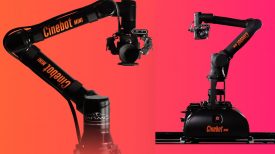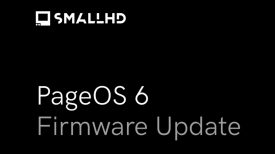Sony today took the wraps off their new PXW-FS5 Super35 4K camera. And what a camera it is. It seems like they have taken all of their latest technologies and rolled them into one sub-$7K machine. Where to start?
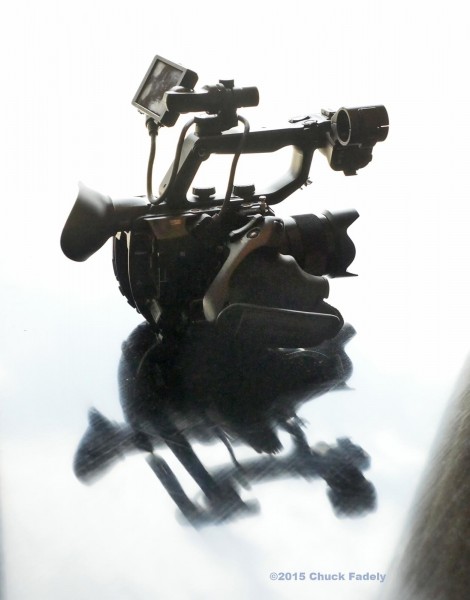
photo: © 2015 Chuck Fadely
The camera sits just below the FS7 in Sony’s Super35mm large sensor camera lineup. It effectively replaces the FS700 and FS100. Like the other FS cameras it has an E-mount and is also compatible with a wide range of lenses via adapters.
It’s smaller and lighter than the FS7. Weighing just 0.8Kg (less than 2 lbs) without grip and handle it is designed as a grab and go machine. It has a modular design with detachable grip, LCD and top handle. There is a built-in EVF at the rear of the body and the whole design is optimised for handheld operation. Attention has been paid to how the camera balances in the hand. It really does feel a lot lighter than the FS7. The small body also makes it a perfect camera for brushless gimbals and smaller Steadicams.
It has the same 12 million pixel sensor as the FS7 which is capable of 14 stops of dynamic range. Base ISO is 3200 ISO – higher than the FS7 – and goes up to 32,000. The camera boots in less than five seconds – which is a huge deal for real world shooters. I’ve missed several shots in my career while waiting for my camera to turn on.
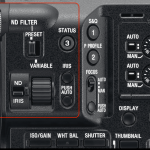
One major innovation is the inclusion of an electronic neutral density (ND) filter system. This is a first on a Super35mm camera and its interesting to see it debut on a lower cost model. The FS5 has both a conventional filter knob and a continuously variable wheel for the neutral density. You can custom set the three ND values on the knob to your liking, from 1/4 to 1/128.
What this allows you to do in bright light is set the ISO, shutter speed and aperture, then use the auto ND feature to keep the exposure constant. This means that depth of field, noise and motion blur can all be kept the same as the light varies. Using the variable ND, you can even do smooth iris pulls using lenses that would normally only stop down in discrete steps.
The camera has improved autofocus when used with native E-mount lenses. It still doesn’t rival the Dual Pixel CMOS AF of the Canon C series, but it does now have a face detection function. You can move the magnification point around the screen.
The camera has a Clear Image Zoom which is Sony speak for a digital zoom. This zooms the image up to 2X when in HD or 1.5X in “QFHD,” Sony speak for 3840×2160 4k. They claim minimal image quality loss. The digital zoom can be activated with the zoom rocker so you can smoothly zoom even with a prime lens. With zoom-enabled lenses, there is a smooth transition from the optical zoom to the digital zoom, just like a consumer camcorder. With the 18-105mm kit lens attached, the PXW-FS5 is a surprisingly compact package with more reach than you’d expect.
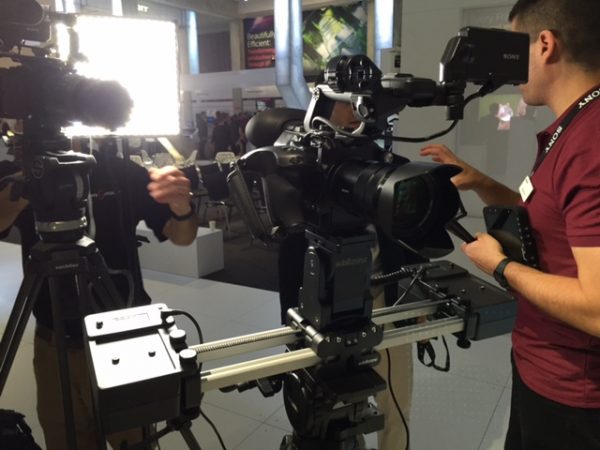
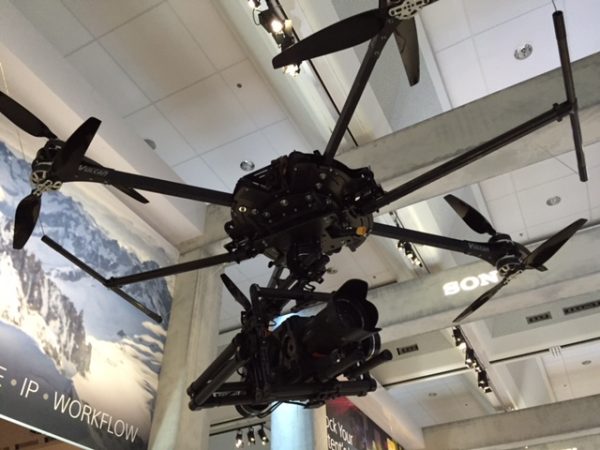
There is also a very useful centre scan mode which allows a HD image to be recorded from the centre portion of the sensor. When engaged, Super16 and broadcast B4 lenses can be used with an appropriate adapter. Between the Clear Image Zoom and the centre scan, documentary and news shooters can greatly extend your lens reach in HD.
Pretty much the only recent high tech feature from Sony that is missing in the FS5 is sensor image stabilisation, as found in the a7R II. It would have been great to see this in the FS5, but maybe we have to wait for version II to see that.
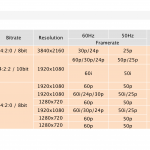
It is a world camera that can record both NTSC and PAL frame rates. It records up to 100 Mb/s 4K XAVC internally to SDXC cards in 8 bit 4:2:0, at 24,25 or 30 fps. Importantly it can also record 1080 HD at 4:2:2 internally, up to 60 fps. AVCHD recording is also available if you really need it. The two card slots can be used for relay recording (switches over when the first card is full) or can be used for simultaneous recording. You can also record at full resolution on one card and at a reduced proxy setting on the other.
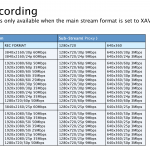
The HD recording quality is a huge advantage for a camera at this price. It beats its major competitors; the Canon C100 mkII and the JVC GY-LS300. It has two SD card slots which make recording media much cheaper than the FS7. If these bitrates or codecs are not to your liking you can also record externally to a recorder using the HDMI or 3G SDI outputs (the SDI output is HD-only at this time.) That isn’t all though. In the future Sony have said the camera will be capable of outputting a RAW signal to an external recorder such as the Atomos Shogun or Convergent Design Odyseey 7Q+. They haven’t given a timescale, or a price for this upgrade this yet though.
Slow motion is well catered for. The camera can record for eight seconds at 240fps in HD, or nineteen seconds at 960fps in 720P. I suspect that this will be similar in quality to the FS7, but the time you can record is more limited than its more expensive sibling.
The usual Sony gammas of Slog 2 and Slog3 are available, along with all the other standard gammas. The colour should be on a par with the FS7. But in white balancing it outshines the FS7 and even the F5 and F55 cameras: If you prefer warmer or cooler or less green or less magenta images, the camera has the ability to bias your base colour balance in the menus. There is a basic rec709 LUT for viewing when you’re shooting in Slog.
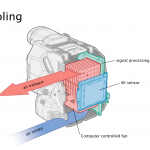

Like most new S35 cameras the FS5 is built around the sensor block and all the components are tightly packed into the magnesium body. The camera has an active cooling system with a big heat sink and fan. Once really nice touch is that all the audio and video connections on the dumb side of the camera are positioned in a way that keeps the cables protected as much as possible.
The handgrip is very similar to the one on the FS7, except it does not attach with ARRI rosettes and there is no extension included with the camera. Instead it locks directly onto the body and feels a bit more like a Canon C series when held. You can however buy accessory rosette adapters from Sony that allow you to mount the FS7 or other arms directly to the camera, and use the grip on the end of an extension arm. You can also use the FS7 grip and EVF on the FS5 interchangeably if you own both cameras. The buttons on the handgrip are assignable and allow you to magnify to check focus and activate autofocus. The grip also has a new handstrap – not something I particularly like but you might think differently.
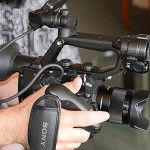
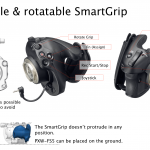
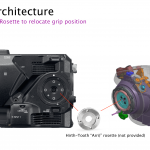
The handgrip doesn’t extend below the body, so the camera will sit flat on a surface. The handgrip communicates with the body via a lanc plug so you can rig the camera with the handgrip anywhere you can mount it via rosette. This is a very flexible camera body, useable in stripped-down minimalist mode or rigged in any configuration imaginable. There are many 1/4-20 mounts on the top of the body when you remove the top handle. There are both 1/4″ and 3/8″ sockets on the bottom.
Audio is one area where the FS7 beats the FS5. The FS5 only has two channels of audio compared to the FS7’s four. There is a single XLR connector on the top handle and another on the side of the camera. You can also use a UWP D wireless mic directly connected via Sony’s proprietary MI shoe on the handle to feed one of the channels if you prefer. There is a stereo mic built into the top grip, but you lose that mic if you take off the top handle.
There is one area where there have been savings made with the FS5. The internal EVF is quite small and placed at the rear of the camera. It is a 1.44 million dot OLED which is not as highly specced as amazingly sharp one in the a7R II. However, the EVF seems to be adequate and is useable by glasses-wearers.
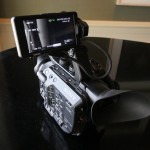
The LCD is a 3.5 inch 1.56million dot display with the same connector as the FS7 LCD/viewfinder. The difference is that you can’t attach a loupe that turns the LCD into an EVF. This was a key design feature of the FS7 because it was designed to be used on the shoulder. For whatever reason Sony designers have chosen to deny FS5 owners this option (although I’m sure there will be some third party solutions in time). The FS5 LCD can however be mounted in several different positions on the camera. As well as the classic slightly forward mount point favoured by handheld users, you can also mount it at rear of the handgrip, or directly to the body of the camera without the top handle attached if you want to keep things really small for gimbal use.
There is a histogram display option, but apparently no waveform – which is something I would personally miss.
The camera runs off the same BP-U type batteries as the FS7 and PMW-F3. On the smallest, lightest BP-U30 Sony claim it can run for about two hours. These are pretty commonplace now and I’m a big fan of using them to power all sorts of other devices too. A BP-U 90 will give almost seven hours.
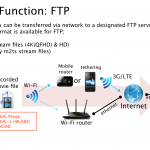
Other specialised features include in camera GPS metadata and also the ability to stream video via wi-fi and send clips via FTP. There is an ethernet socket that can also be used to download the video from the camera. This could be useful if the camera is installed in a remote location at an event. The wifi is built into the body – no dongle needed. You can also control some camera functions over your smartphone.
In all this looks to be a dream camera for many factual and documentary shooters on tighter budgets. Fast operation coupled with codecs and bitrates that should satisfy many broadcasters is a potent combination. It would of course be better to have higher 4K bitrates and 4:2:2 onboard, but if really you need that you can add a recorder or move up to the the FS7.
Whether renting, or buying the FS5 is sure to prove popular if Sony can supply them in significant numbers and they prove to be reliable.
The camera is due to ship in mid-November, and at a price of $7299 with 18-105mm lens, or $6699 body only, it is likely to give other camera makers a few sleepless nights.
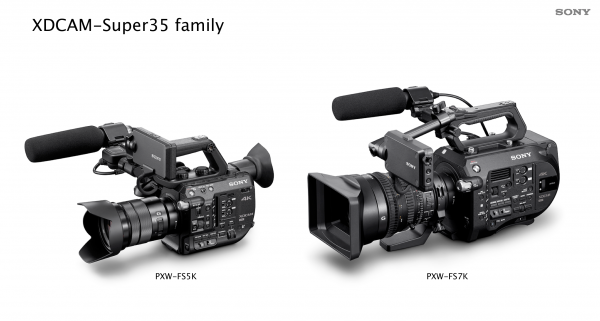
Here’s Sony’s press release:
SONY EXPANDS LARGE SENSOR CAMERA FAMILY
WITH NEW 4K COMPACT SUPER35 CAMCORDER
New PXW-FS5 Adds Creative Flexibility to Sony’s
Line of Professional 4K Production Technologies
Park Ridge, N.J., September 11, 2015 — Sony is expanding its line of large sensor 4K technologies with the PXW-FS5 compact Super 35mm camcorder. The new model rounds out Sony’s line of 4K professional cameras, and fills an important niche between cameras like Sony’s PXW-FS7 and the NEX-FS700.
As a companion camera or on its own, the PXW-FS5 fits a range of applications, including documentary and independent filmmaking, online content creation, student film projects and even DSLR users looking to “step up.”
“We are continually developing and growing the most complete, fully featured line of cameras for every level of production, and the new FS5 model is the missing piece our customers need,” said Francois Gauthier, Director of Digital Imaging, Sony’s Professional Solutions Americas. “Sony has the right production tool for any application – HD, 2K or 4K – and for any budget.”
Sony’s PXW-FS5K camcorder
The PXW-FS5 is ergonomically designed for versatile, hand-held shooting. The lightweight body has excellent weight balance, ensuring reliability and all-day comfort. It can be used in almost any location, even airborne when mounted on a drone. A variety of shooting angles is possible with the one-touch rotatable grip. All key controls are at the user’s fingertips, allowing for shooting flexibility and instant switching between low or high angle shooting.
Users can attach the 3.5-inch type LCD panel to different positions on the handle or the compact camera body, further supporting easy handheld operation and customized shooting.
Capable of 4K XAVC high-definition shooting, the camera’s Super35 Exmor™ CMOS sensor incorporates 11.6 million pixels and 8.3 million effective pixels. The high sensitivity and large size of the sensor delivers background defocus, increased low-light sensitivity and lower image noise. High-quality imagery is further ensured by high frame rate cache recording at 10-bit 4:2:2 Full HD and a high frame rate of up to 240 fps, in 8 second bursts, which makes 1/10 times Super Slow Motion possible without sacrificing bit depth or loss of image quality.
Sony’s PXW-FS5 (right) and PXW-FS7 camcorders, and family of lenses
The PXW-FS5 is the first Super35 camcorder to feature built-in electronic variable ND filters, further expanding the depth of field representation by the large-format sensor and enabling flexible exposure control.
The compact power zoom E lens PZ 18-105mm F4 G OSS (SELP18105G), provided in the PXW-FS5K kit model enables zoom operation with one hand.
Integrating easily with other camera lenses, Sony’s α Mount System offers compatibility with both Sony and third-party lenses. The PXW-FS5’s E-mount can take virtually any lens, such as SLR lenses via an adapter, as well as Sony’s E-mount and A-mount lenses, ensuring the camera adapts to multiple environments. Sony’s α Mount System and its enhanced interfaces include 3G-SDI, HDMI output and dual SD card slots. Also equipped with Wi-Fi and a wired LAN terminal, the PXW-FS5 features enhanced network functions such as file transfer and streaming transmission. A planned future firmware update will provide RAW output.
Key features of the PXW-FS5:
Flexible handheld shooting with a lightweight body
The lightweight (1 lb., 13.2 oz.) body with excellent weight balance ensures comfortable handheld shooting as well as an easy fit with a drone or gimbal. The one-touch rotatable grip enables instant switching between low or high angle shooting. Shooting parameters can be changed with one hand even during recording by using the multi-functional grip. The zoom can be operated similarly with a single hand. The detachable handle, one-touch rotatable grip and flexible LCD panel support various shooting styles.
4K shooting and 240 fps high-speed shooting
The camera is equipped with an 11.6 million pixel Super35 Exmor™ CMOS Sensor, enabling 4K XAVC long GoP high-definition video shooting. It is the world’s first Super35 camcorder with a built-in electronic variable ND filter, supporting linear control from 1/4ND to 1/128ND and further expanding the depth of field representation. 1/10 times Super Slow Motion reproduction is possible through 10-bit 4:2:2 full HD 240fps High Frame Rate, with no sensor cropping. Low light capabilities and background defocus are heightened by the high sensitivity and large sensor size. 14 stops of latitude in exposure deliver strong grayscale rendition without crushing shadows or blowing out light details.
Variety of shooting applications and rich network functions
The camera’s interfaces include 3G-SDI, 4K HDMI output, MI shoe, dual SD card slots, Wi-Fi and wired LAN terminal, supporting various system configurations. The Clear Image Zoom feature allows users to zoom in at up to 2x, even with a fixed focal length lens.
Find out more about the PXW-FS5 at www.sony.com/fs5.
The PXW-FS5 is planned to be available in November 2015, at the following suggested list pricing:
- PXW-FS5, body only — $6,699
- PXW-FS5K, with lens — $7,299




